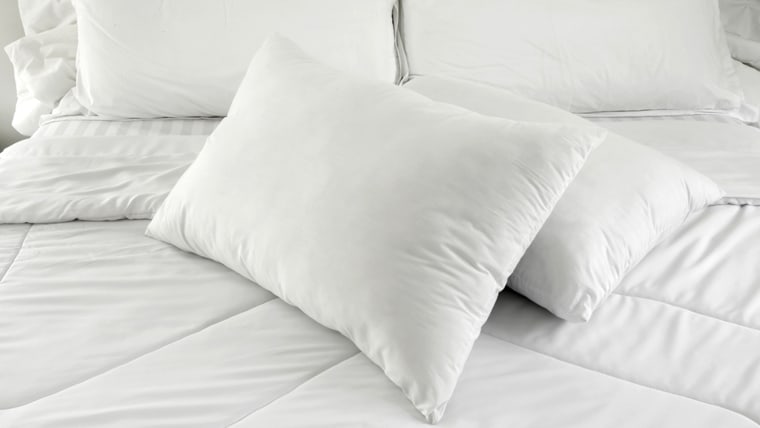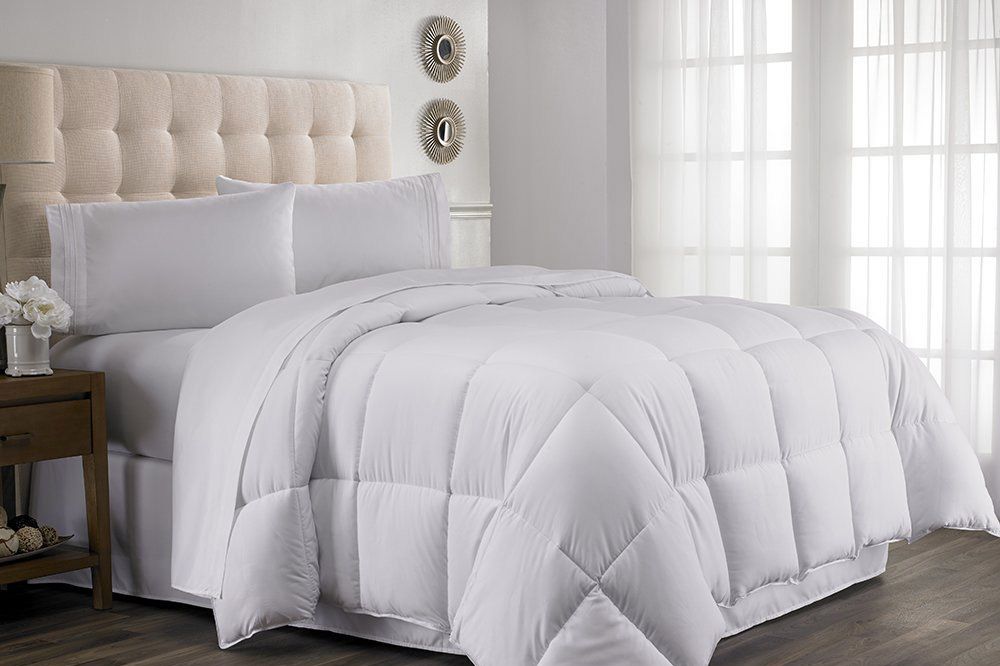How often you should replace everything in your bedroom: Rules Celebs follow
The National Sleep Foundation tells us to plan on replacing pillows every year or two.

As we head into spring cleaning season we suddenly remember all those things that should probably be washed. How long since those curtains have seen the inside of a washing machine, anyway? It's also a good time of year to take stock and think about replacing things, like say that mattress you've had since the Clinton administration.
In honor of your birthday, why not take a spin around your bedroom and see what might need freshening up?
MATTRESS
WHEN TO TOSS IT: 10 YEARS
Let's start with the bed. Do you even remember how long you've had your mattress? If it's more than 10 years, according to Consumer Reports, it probably time to go shopping. Depending on the type of bed, says all-things-sleep review site Sleep Like the Dead, it could be even less time; their research shows latex mattresses last around eight years, memory foam around seven, and innerspring even less.
Consumer Reports has more bad news. If you're over 40 you can expect even less time out of a bed, since “your body tolerates less pressure as it ages,” they say.
How do you know when it's time for out with the old and in with the new? Just listen to your body. If it's “generally uncomfortable, or you’ve been waking up with back pain, it may be time for a new one,” says the National Sleep Foundation. (Or maybe you could just try these wake-up stretches!)
PILLOWS
WHEN TO TOSS THEM: 1 TO 2 YEARS
And how about where you lay your weary head? The National Sleep Foundation tells us to plan on replacing pillows every year or two. Why so often? Apparently they “absorb body oil, dead skin cells, and hair,” which can “create the perfect environment for dust mites (common allergens).” They also recommend washing your pillows every six months and using a protective case between the pillow and pillowcase. How do you know when it's time for a new pillow? “Fold it in half and see if it stays that way,” they say. “If it does, it’s time for a new one.” If you spring for a quality down pillow and take good care of it, lifestyle guru Martha Stewart says you can get 10 or 15 years out of them.
SHEETS
WHEN TO TOSS THEM: 2 YEARS
Sheets can be a big outlay. How long should we expect them to last? It runs the gamut very much like the price does. Most people will replace them within two years, according to a bedroom poll from the National Sleep Foundation. Co-founder of Brooklinen Vicki Fulop says that sounds about right. “After regular use and wash cycles, the fibers of your bed linens can start to break down and show signs of wear and tear.” But don't tell Siri to remind you in 2020 just yet. “Having said that, it doesn't mean your sheets will all of a sudden fall apart after two years,” Fulop notes, “just that if they're starting to look and feel worn out, and you want the optimal condition and comfort for your bed, two years or so is a great time for a refresh.”
COMFORTERS AND DUVETS
WHEN TO TOSS THEM: 15 TO 25 YEARS
Luckily, we can expect comforters to last longer. “Because it doesn't have to support weight the way pillows and mattresses do,” according to Stewart, “your comforter should last 15 to 25 years if you keep it covered and air it regularly.” No way you'll remember how long you've had it? “Replace it when it begins to look limp and flat or starts leaking bits of filling,” she says.


HUMIDIFIERS AND DEHUMIDIFIERS
WHEN TO TOSS IT: 6 TO 9 YEARS
Many of us find that the right humidity level can help with a good night's sleep which means we may run a humidifier in the winter months and dehumidifier in the summer. But it's not just set it and forget it. Twice a year we should be checking our dehumidifier's filter for tears or damage and replacing it if necessary, according to online parts store Repair Clinic, and once a year the filter should be replaced altogether (or cleaned if that's an option). You can expect about six to nine years out of the dehumidifier itself. For humidifiers, replace the pad, filter or element yearly — once mineral deposits build up, they're difficult to remove.
BRAS AND UNDERWEAR
WHEN TO TOSS THEM: 6 MONTHS TO A YEAR
Your closet and dresser could stand a once-over, too. While your mileage may vary on clothes, from a season to forever, your underthings have a much more defined — and shorter – lifespan. Good Housekeeping recommends replacing bras and underwear every six months to a year, and sooner if they shrink, stretch, or otherwise become uncomfortable or no longer fit properly. That said, with excellent care, a really good bra — especially if you have them in rotation — can last years.
WHILE YOU'RE REPLACING YOUR LINENS, CONSIDER THE LIGHTING TOO
WHILE YOU'RE REPLACING YOUR LINENS, CONSIDER THE LIGHTING TOO
Now's a good time to think about replacing the lights in your bedroom. Not because they've gone bad, but for a better night's sleep. Look for low-watt bulbs (around 60) that filter out sleep-disrupting blue lights, says the National Sleep Foundation.

COSMETICS
WHEN TO TOSS THEM: 3 MONTHS TO 2 YEARS
When we find that perfect mascara we may be loathed to let it go. But let it go we must, along with other cosmetics, the FDA warns. Citing a veritable cornucopia of ick factors — bacteria, mold, and yeast —they note that manufacturers usually recommend discarding mascara two to four months after purchase. In fact, all eye-area cosmetics have shelf lives shorter than that of other makeup. Tempted to overlook their advice? They'd remind you that eye infections from makeup gone bad can be serious.
Cosmetic manufacturers aren't required to put use-by dates on products but Good Housekeeping shares some best practices. They say three months for liquid eyeliners, six months for cream eyeshadows; and two years for pencil eyeliners and powder eyeshadows. Liquid face makeup should go after six months, but you can hang onto dry powders for two years. They give two years to lipstick and gloss and at least that for lipliner.
As for skin care, plan for six months, or a year for products in pump bottles. Their tip: Keep your beauty regimen out of the bathroom where heat can speed up the bacterial and fungal growth. A linen closet is a better place to stash that cosmetic bag.MAKE-UP APPLICATORS
WHEN TO TOSS THEM: 2 TO 3 MONTHS
Are you washing your brushes regularly? Good. The bad news is they still won't last forever. Elle magazine experts say you should be buying new brushes every three months if they start to shed, smell or are discolored. As for that foam blending sponge, In Style says that needs to be replaced at least every three months, if not two — and that's if you're keeping it clean.
TOOTHBRUSHES
WHEN TO TOSS THEM: 3 TO 4 MONTHS
You know these guys don't last forever. What's their lifespan? The American Dental Association says you should replace your toothbrush every three to four months. For nightmare material, read their treatise on bacterial growth.
HAIRBRUSHES
WHEN TO TOSS THEM: 6 MONTHS TO A YEAR
Yep, these need to be replaced too. Even with regular cleaning (are you doing that?) to keep from weighing your hair down with accumulated gunk, hairbrushes still have a limited life — about six months to a year, according to Women's Health magazine. How will you know when it's time to say goodbye? Bristles separating is the warning sign, they say, but when the bed starts to crack and your hair catches it's time to give it the brush-off.
DISPOSABLE RAZORS
WHEN TO TOSS THEM: EVERY 5 TO 7 SHAVES
Here's the million dollar question: How long can you use that disposable razor languishing in your bathroom? The American Academy of Dermatology recommends replacing it after every five to seven shaves to avoid irritation — and if you're keeping it in the shower, get it out of there, stat. Razors should be kept dry in order to avoid bacteria growth, they warn. If a handful of shaves doesn't cut it for you, you're not alone. A whole movement has sprung up around getting the most use out of these throwaways, with some proponents going to great lengths (drying, oiling, running the blade along jeans) to get months — if not years — out of a single plastic razor.
TOILET SCRUBBER
WHEN TO TOSS IT: AFTER A BOUT WITH THE STOMACH FLU
What has the dirtiest job in the house? It would be hard to think of something working harder than the toilet scrubber. So not only does it need its own TLC, it's got an expiration date. Home site Hunker says as long as you're disinfecting it regularly, you can keep it until the bristles start to go bad, so keep an eye on that. One caveat, though, says biology professor Elizabeth Scott, Ph.D, co-director of Simmons Center for Hygiene and Health in Home and Community. If someone in the home has had a gastrointestinal illness, the scrubber used to clean after them has got to go because “now you're dealing with infectious materials.” If you don't want to throw it away, we've got one word for you: bleach.


Comments
Post a Comment